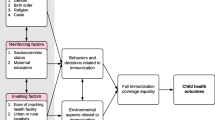Abstract
This study focuses on the estimation of demand for immunization as well as its technological effect on the survival probability of a child in rural India. Careful attention is paid to the consequences of parental selection on survival technology and demand for health inputs. The results suggest that child mortality is negatively related to the likelihood of purchasing vaccination, but imperfect vaccination substantially reduce the beneficial effect. Results also suggest that a mother who perceives her child faces a risk of higher likelihood of death compensates for their beliefs in a beneficial way. Consequently, estimations that ignore this selection underestimate the impact of immunization on child survival. Mothers also engage in complementary behavior by reinforcing investment when they choose among health inputs. Estimations that ignore the complementarity substantially overstate the impact of prenatal care and delivery care on demand for immunization. The evidence for complementarity among measured inputs also implies that there might be favorable selection between measured and unmeasured inputs, although the adverse selection seems dominant in this study.
Similar content being viewed by others
References
Gary S Becker (1965) ArticleTitle“A Theory of the Allocation of Time” Economic Journal 75 493–517
Albino Barrera (1990) ArticleTitle“The Interactive Effects of Mother’s Schooling and Unsupplemented Breastfeeding on Child Health” Journal of Development Economics 34 81–98 Occurrence Handle10.1016/0304-3878(90)90077-O
John Bound Jaeger David A Baker Regina M (1995) ArticleTitle“Problems with Instrumental Variables Estimation When the Correlation between the Instruments and the Endogenous Explanatory Variables is Weak” Journal of American Statistical Association 90 443–450
Angus Deaton (1997) The Analysis of Household Surveys, chapter 1 The Johns Hopkins University Press Baltimore
Jeffrey E Harris (1982) “Prenatal Medical Care and Infant Mortality” R. Fuchs Victor (Eds) Economic Aspects of Health The University of Chicago Press Chicago
Noreen Goldman Pebley Anne R (1994) ArticleTitle“Health Cards, Maternal Reports, and the Measurement of Immunization Coverage in Guatemala” Social Science and Medicine 38 1075–1089 Occurrence Handle1:STN:280:ByuA3MjgtF0%3D Occurrence Handle8042056
L. Gortmaker Steven (1979) ArticleTitle“The Effects of Prenatal Care upon the Health of Newborn” American Journal of Public Health 69 653–660 Occurrence Handle453391
Michael Grossman (1972) ArticleTitle“On the Concept of Health Capital and Demand for Health” Journal of Political Economy 80 223–255 Occurrence Handle10.1086/259880
Michael Grossman Joyce Theodore J (1990) ArticleTitle“Unobservables, Pregnancy Resolutions, and Birth Weight Production in New York City” Journal of Political Economy 98 983–1007 Occurrence Handle10.1086/261716
InstitutionalAuthorNameIIPS(InternationalInstitutefor Population Sciences) (1995) National Family Health Survey MCH and Family Planning Bombay, India
InstitutionalAuthorNameIIPS (2000) National Family Health Survey (NFHS-2) MCH and Family Planning Bombay, India
J. Joyce Theodore (1994) ArticleTitle“Self-Selection, Prenatal Care, and Birthweight among Blacks, Whites, and Hispanics in New York City” Journal of Human Resources 29 762–794
Munshi Rakesh., Sang-Hyop Lee. (2000). Child Immunization in Madhya Pradesh, National Family Health Survey Subject Reports, no. 15, Mumbai: Institutional Institute for Population Sciences; and Honolulu: East-West Center Program on Population and Health
J. Olsen Randall Wolpin Kenneth I (1983) ArticleTitle“The Impact of Exogenous Child Mortality on Fertility: a Waiting Regression with Dynamic Regressors” Econometrica 51 731–749
W.A. Panis Constantijn Lillard Lee A (1994) ArticleTitle“Health Inputs and Child Mortality: Malaysia” Journal of Health Economics 13 455–489 Occurrence Handle10140534
R. Pebley Anne Goldman Noreen Rodriguez German (1996) ArticleTitle“Prenatal and Delivery Care and Childhood Immunization in Guatemala: Do Family and Community Matter? Demography 33 231–247 Occurrence Handle8827167
Mark R Rosenzweig T Paul Schultz (1982) ArticleTitle“Child Mortality and Fertility in Colombia: Individual and Community Effects” Health Policy and Education 2 305–348 Occurrence Handle1:STN:280:Bi2B28vos1c%3D Occurrence Handle10256651
Rosenzweig Schultz (1983) ArticleTitle“Estimating a Household Production Function: Heterogeneity, the Demand for Health Inputs, and Their Effects on Birth Weight” Journal of Political Economy 91 23–46
Rosenzeweig Schultz (1988) ArticleTitle“The Stability of Household Production Technology A Replication” Journal of Human Resources 23 535–549
Rosenzeweig Schultz (1991) ArticleTitle“Who Receives Medical Care? Income, Implicit Prices, and the Distribution of Medical Services among Pregnant Women in the United States” Journal of Human Resources 26 473–508
R. Rosenzeweig Mark Wolpin Kenneth I (1988) ArticleTitle“Heterogeneity, Intrafamily Distribution, and Child Health” Journal of Human Resources 23 437–461
Rosenzeweig Schultz (1995) ArticleTitle“Sisters, Siblings and Mothers: the Effects of Teen-Age Child Bearing on Birth Outcomes” Econometrica 63 303–326 Occurrence Handle12289811
John Strauss (1986) ArticleTitle“Does Better Nutrition Raise Farm Productivity?” Journal of Political Economy 94 297–320 Occurrence Handle10.1086/261375
Strauss, John and Duncan Thomas. (1995). “Human Resources: Empirical Modeling of Household and Family Decisions.” In J.R. Behrman, and T.N. Srinivasan (eds.), Handbook of Development Economics, Vol. 3. Amsterdam: North-Holland
Donna Strobino et al. (1996) ArticleTitle“Parental Attitudes Do Not Explain Under-Immunization” Pediatrics 98 1076–1083 Occurrence Handle1:STN:280:ByiC3cfpslI%3D Occurrence Handle8951256
WHO (World Health Organization). (1986). The Expanded Programme on Immunization in South-East Asia, SEARO Regional Health Papers 12, India, New Delhi
WHO. (1998). Report of the Technical Review Group Meeting, 7–8 June 1998, Vaccine Research and Development. WHO/VRD/GEN/98.02
Wolpin, Kenneth I. (1997). “Determinants and Consequences of the Mortality and Health Inputs of Infants and Children,” In: M.R. Rosenzweig and O. Stark (eds.), Handbook of Population and Family Economics, Vol. 1, Amsterdam: North-Holland
Author information
Authors and Affiliations
Corresponding author
Additional information
Useful comments were received from Michael Grossman, John Strauss, Agnes Quisumbing, Robert Retherford, Rakesh Munshi, DoAnne Sanchez, Kathleen Beegle, seminar participants in the Econometric Society meeting and University of Hawaii, and two anonymous referees. I would like to thank Gayle Yamashita and Vicky Ho for their assistance with compiling data.
Rights and permissions
About this article
Cite this article
Lee, SH. Demand for Immunization, Parental Selection, and Child Survival: Evidence from Rural India. Rev Econ Household 3, 171–196 (2005). https://doi.org/10.1007/s11150-005-0709-x
Received:
Accepted:
Issue Date:
DOI: https://doi.org/10.1007/s11150-005-0709-x




